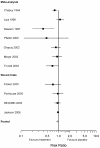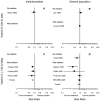Fracture prevention with vitamin D supplementation: considering the inconsistent results
- PMID: 17349055
- PMCID: PMC1821327
- DOI: 10.1186/1471-2474-8-26
Fracture prevention with vitamin D supplementation: considering the inconsistent results
Abstract
Background: A meta-analysis found that high dose vitamin D, different from low dose, decreased fracture risk by 23% for any nonvertebral fracture and by 26% for hip fracture. Unfortunately, however, this effect was not confirmed by recent trials. The aim of this paper is to explore if this inconsistency can be attributed to publication bias or heterogeneity of the trials.
Methods: The meta-analysis was extended with recent randomised controlled trials (RCTs) that were identified by a systematic review. Risk ratios (RR) and 95% confidence intervals (CI) were calculated from raw data. A funnel plot was used to explore the possibility of publication bias. Forest plots were used to investigate if vitamin D dose, concurrent use of calcium and target population were sources of heterogeneity. Linear regression analysis of log RR on adherence rate and achieved vitamin D level was used to study whether these variables were associated with fracture risk.
Results: A total of eleven trials was included: seven RCTs from the meta-analysis and four recently published. For any nonvertebral fracture, the funnel plot was asymmetrical because two small RCTs showed a large positive effect. This was not found for hip fracture. As reported in the meta-analysis, low dose vitamin D (<400 IU daily) was not effective. In contrast to the meta-analysis, however, the effect of high dose vitamin D (> or =700 IU daily) seemed to be dependent on target population. For any nonvertebral fracture, the pooled RR was 0.80 (95% CI, 0.70-0.90) in institutionalised persons, and 0.88 (95% CI, 0.75-1.04) in the general population; for hip fracture, pooled RR 0.72 (95% CI, 0.59 to 0.88) and 1.04 (95% CI, 0.72-1.50), respectively. Other sources of heterogeneity were not clearly found. In the meta-analysis, pooled RRs were mainly based on small trials that showed a large effect or trials in institutionalised persons.
Conclusion: It is likely that the inconsistency between the meta-analysis and the recent trials is, at least partially, due to publication bias and differences in target population. High dose vitamin D may be effective in institutionalised persons but probably is not effective in the general population.
Figures





References
-
- Porthouse J, Cockayne S, King C, Saxon L, Steele E, Aspray T, Baverstock M, Birks Y, Dumville J, Francis R, Iglesias C, Puffer S, Sutcliffe A, Watt I, Torgerson DJ. Randomised controlled trial of calcium and supplementation with cholecalciferol (vitamin D3) for prevention of fractures in primary care. BMJ. 2005;330:1003–1006. doi: 10.1136/bmj.330.7498.1003. - DOI - PMC - PubMed
-
- Grant AM, Avenell A, Campbell MK, McDonald AM, MacLennan GS, McPherson GC, Anderson FH, Cooper C, Francis RM, Donaldson C, Gillespie WJ, Robinson CM, Torgerson DJ, Wallace WA. Oral vitamin D3 and calcium for secondary prevention of low-trauma fractures in elderly people (Randomised Evaluation of Calcium Or vitamin D, RECORD): a randomised placebo-controlled trial. Lancet. 2005;365:1621–1628. doi: 10.1016/S0140-6736(05)63013-9. - DOI - PubMed
-
- Avenell A, Gillespie WJ, Gillespie LD, O'Connell DL. Vitamin D and vitamin D analogues for preventing fractures associated with involutional and post-menopausal osteoporosis. Cochrane Database Syst Rev. 2005:CD000227. - PubMed
-
- Jackson RD, LaCroix AZ, Gass M, Wallace RB, Robbins J, Lewis CE, Bassford T, Beresford SA, Black HR, Blanchette P, Bonds DE, Brunner RL, Brzyski RG, Caan B, Cauley JA, Chlebowski RT, Cummings SR, Granek I, Hays J, Heiss G, Hendrix SL, Howard BV, Hsia J, Hubbell FA, Johnson KC, Judd H, Kotchen JM, Kuller LH, Langer RD, Lasser NL, Limacher MC, Ludlam S, Manson JE, Margolis KL, McGowan J, Ockene JK, O'Sullivan MJ, Phillips L, Prentice RL, Sarto GE, Stefanick ML, Van Horn L, Wactawski-Wende J, Whitlock E, Anderson GL, Assaf AR, Barad D. Calcium plus vitamin D supplementation and the risk of fractures. N Engl J Med. 2006;354:669–683. doi: 10.1056/NEJMoa055218. - DOI - PubMed
Publication types
MeSH terms
Substances
LinkOut - more resources
Full Text Sources
Medical
Research Materials

